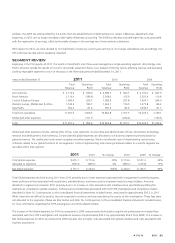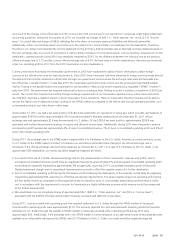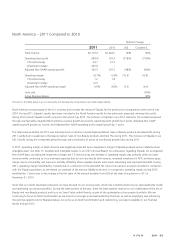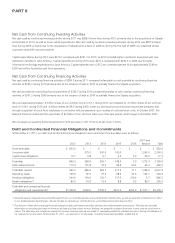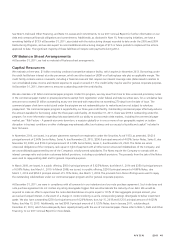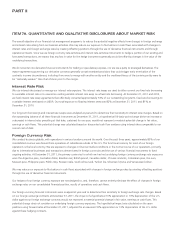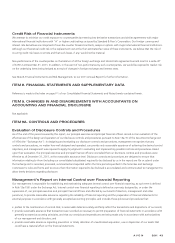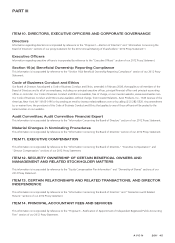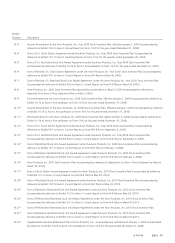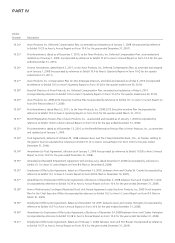Avon 2011 Annual Report Download - page 47
Download and view the complete annual report
Please find page 47 of the 2011 Avon annual report below. You can navigate through the pages in the report by either clicking on the pages listed below, or by using the keyword search tool below to find specific information within the annual report.
Retirements of debt will depend on prevailing market conditions, our liquidity requirements, contractual restrictions and other factors, and
the amounts involved may be material. We may also elect to incur additional debt or issue equity or convertible securities to finance ongoing
operations, acquisitions or to meet our other liquidity needs.
In July 2010, Avon completed the purchase of substantially all the assets and liabilities of Silpada for approximately $650 in cash. The
acquisition was funded with cash and commercial paper borrowings. Refer to Note 17, Goodwill and Intangible Assets, to our 2011 Annual
Report for more details.
Any issuances of equity securities or convertible securities could have a dilutive effect on the ownership interest of our current shareholders
and may adversely impact earnings per share in future periods.
Our liquidity could also be impacted by dividends, capital expenditures, acquisitions, and certain contingencies described more fully in Note
16, Contingencies, to the consolidated financial statements included herein. At any given time, we may be in discussions and negotiations
with potential acquisition candidates. Acquisitions may be accretive or dilutive and by their nature involve numerous risks and uncertainties.
See our Cautionary Statement for purposes of the “Safe Harbor” Statement under the Private Securities Litigation Reform Act of 1995.
Balance Sheet Data
2011 2010
Cash and cash equivalents $1,245.1 $1,179.9
Total debt 3,308.4 3,136.2
Working capital 1,207.8 1,228.0
Cash Flows
2011 2010 2009
Net cash from continuing operating activities $ 655.8 $ 689.0 $ 754.7
Net cash from continuing investing activities (267.7) (1,095.7) (218.3)
Net cash from continuing financing activities (284.5) 234.7 (361.2)
Effect of exchange rate changes on cash and equivalents (37.2) (33.7) 5.6
Net Cash from Continuing Operating Activities
Net cash provided from continuing operating activities during 2011 was $33.2 lower than 2010. Operating cash flow during 2011 was
negatively impacted by a $75.0 contribution to the U.S. pension plan, a payment associated with a long-term incentive compensation plan
of approximately $36, and higher payments associated with CTI restructuring. Partially offsetting these unfavorable comparisons were higher
cash related net income and the higher recovery of value added taxes in Brazil.
Net cash provided from continuing operating activities during 2010 was $65.7 lower than 2009, primarily due to both higher inventories
resulting from lower-than-expected sales and the negative impacts of timing of restructuring payments. Offsetting these unfavorable
comparisons are the recovery of value added taxes in Brazil.
Inventory levels increased during 2011, to $1,161.3 at December 31, 2011, from $1,152.9 at December 31, 2010, primarily reflecting the
benefit of favorable foreign exchange offset by the adverse impact of the ERP implementation in Brazil and lower-than-expected sales. New
inventory life cycle management processes leveraged with initiatives such as ERP implementation and the Sales and Operations Planning
process are expected to improve inventory levels in the long-term. Inventory days are down 2 days in 2011 as compared to 2010, due to the
benefit of favorable foreign exchange offset by the adverse impact of the ERP implementation in Brazil and lower-than-expected sales.
We maintain defined benefit pension plans and unfunded supplemental pension benefit plans (see Note 12, Employee Benefit Plans to our
2011 Annual Report). Our funding policy for these plans is based on legal requirements and cash flows. The amounts necessary to fund future
obligations under these plans could vary depending on estimated assumptions (as detailed in “Critical Accounting Estimates”). The future
funding for these plans will depend on economic conditions, employee demographics, mortality rates, the number of associates electing to
take lump-sum distributions, investment performance and funding decisions. Based on current assumptions, we expect to make contributions
in the range of $40 to $45 to our U.S. pension plans and in the range of $40 to $45 to our international pension plans during 2012.
A V O N 2011 39


